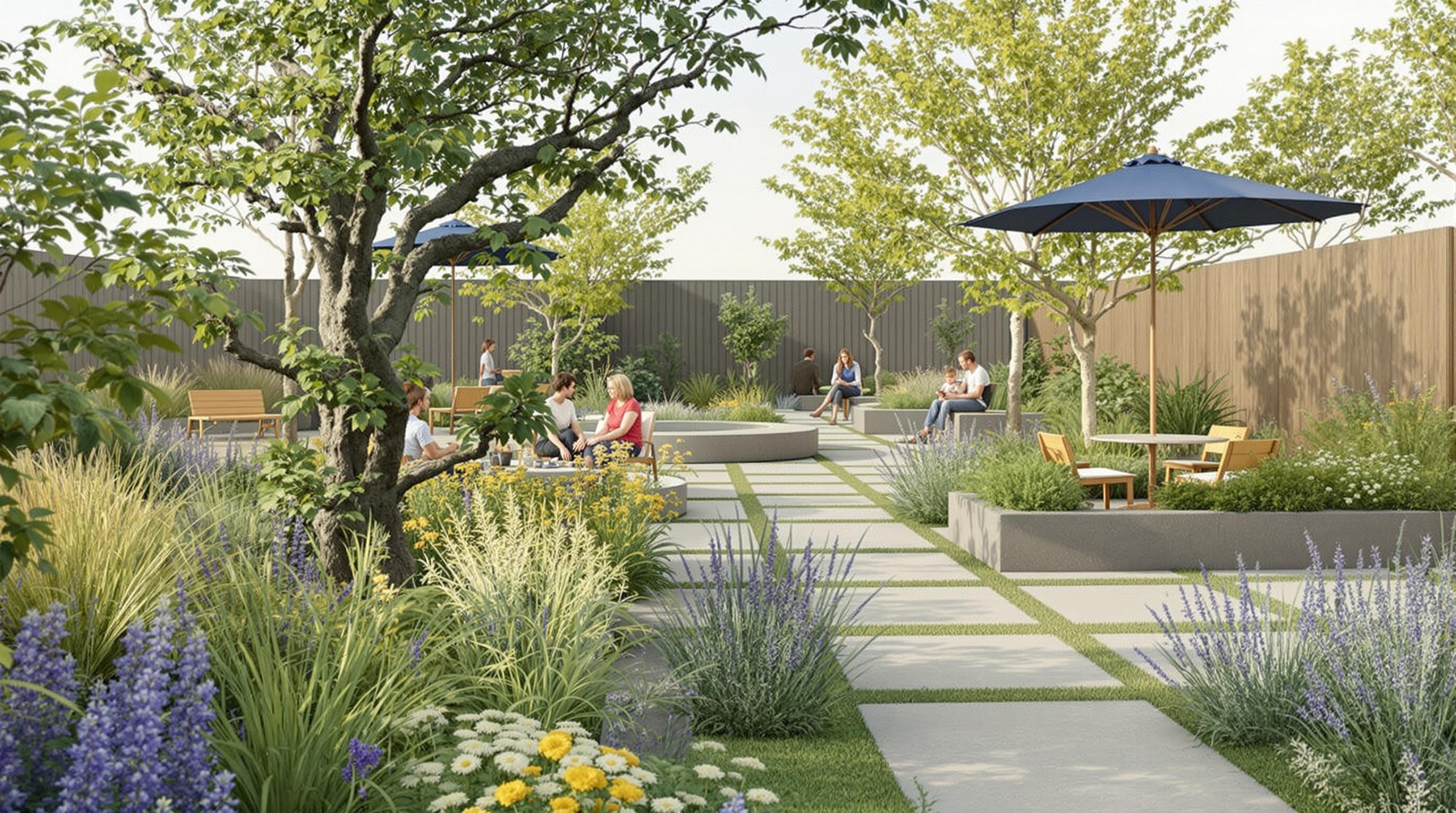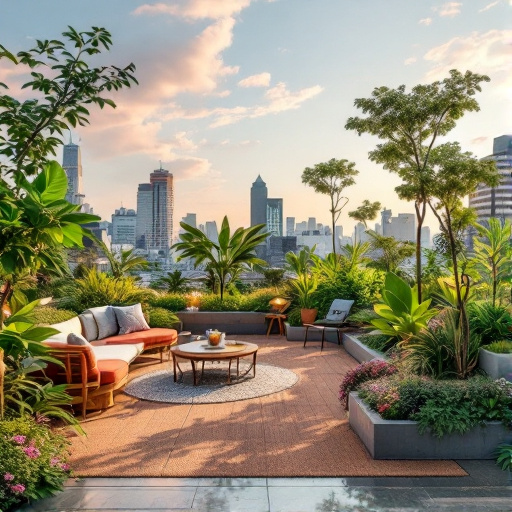Featured Articles
- 12 Innovative Strategies to Design Outdoor Spaces that Enhance Mental Wellness and Cognitive Function
- Blending Nature and Nostalgia: Designing Outdoor Spaces Inspired by Forgotten Childhood Playgrounds
- Rewilding Urban Landscapes: Transforming Concrete Jungles into Biodiverse Outdoor Sanctuaries
- Rewilding Urban Spaces: Designing Outdoor Retreats Through Nature's Chaotic Beauty
- Unconventional Outdoor Oasis: Transforming Urban Rooftops into Lush Green Retreats for Mindful Living
Unconventional Outdoor Oasis: Transforming Urban Rooftops into Lush Green Retreats for Mindful Living
Unconventional Outdoor Oasis: Transforming Urban Rooftops into Lush Green Retreats for Mindful Living
Urban rooftops hold untapped potential as havens for relaxation and mindfulness, transforming concrete jungles into green retreats. This article explores the myriad ways to create serene outdoor spaces atop city buildings, enhancing well-being and fostering a connection with nature.
Why Urban Rooftops?
Did you know that over 50% of the world’s population now resides in urban areas? As cities become more crowded, the need for personal green spaces is more crucial than ever. Urban rooftops, often ignored and underutilized, present an incredible opportunity to create lush, green retreats right above our busy streets. These spaces not only allow residents to escape the hustle and bustle of city life but also promote sustainability and environmental consciousness.
The Benefits of a Rooftop Oasis
Creating an outdoor oasis on a rooftop offers numerous benefits, including psychological, environmental, and social advantages. Studies have shown that green spaces empower individuals and communities by enhancing mental health, promoting physical activity, and even increasing social interactions (Kaplan, R., & Kaplan, S., 1989). Imagine stepping out of your apartment and finding a cozy nook filled with fragrant flowers, vibrant greenery, and even a small herb garden. It’s an instant mood booster! It’s fascinating to consider that access to green space can reduce stress by 20%, according to a 2020 study published in the Journal of Environmental Psychology. Can you believe that just looking at greenery can elevate your spirits?
Designing Your Rooftop Retreat
So, how do you create this urban oasis? Here’s a step-by-step guide:
- Assess Your Space: Measure the size of your rooftop, noting any elements like chimneys and HVAC units that could affect your design.
- Gather Inspiration: Pinterest and Instagram are overflowing with ideas for urban gardens. Look for rooftop gardens you admire and take notes on the elements you love.
- Choose Plants Wisely: Opt for native plants which require less maintenance and are adapted to your climate. Consider vertical gardens to save space!
- Furniture Selection: Comfortable seating can make your oasis inviting. Think about weatherproof furniture that’s both stylish and durable.
- Budgeting: Create a budget that includes plants, furniture, and any structural changes needed.
- Start Small: If a full makeover seems overwhelming, start with smaller projects—maybe a few potted plants or a small seating area.
Case Studies: Rooftop Transformations Around the World
One of the most inspiring transformations is the High Line in New York City, a former elevated railway turned public park. Once neglected and overgrown, it is now a stunning example of how urban spaces can be repurposed into lush, vibrant environments enjoyed by locals and tourists alike. Spanning 1.45 miles, the High Line features native vegetation and beautiful art installations. Ever heard of a place that went from trash to treasure?
In Tokyo, the Rooftop Garden at the New Otani Hotel showcases an incredible array of flora, allowing guests to experience a slice of nature without leaving the city. This rooftop garden not only rejuvenates its patrons but also serves as an ecological haven, providing a habitat for local wildlife, including birds and insects. It’s a perfect case study on how a rooftop can benefit both the urban ecosystem and human well-being.
Overcoming Common Challenges
Let’s be real: transforming a rooftop isn’t always sunshine and rainbows. There are challenges to consider, from structural concerns to plant maintenance. Not every rooftop is equipped to bear the weight of a garden or even furniture. Consulting with an architect or structural engineer can save you a lot of headaches down the line.
Additionally, factors such as wind, sunlight, and access to water can make landscaping tricky. Urban rooftops often experience high winds and unpredictable weather. As a solution, consider using wind-resistant plants or installing windbreaks to protect your garden. Take this as a learning moment: sometimes the challenges shape our creativity!
The Role of Mindfulness in Gardening
Gardening is not just about aesthetics—it's a practice rooted in mindfulness. According to a 2021 study published in the journal *Health** and *Place*, individuals who engage in gardening report significantly lower levels of anxiety and increased feelings of well-being. Think of the soothing sounds of nature: soil under your fingers, leaves rustling in the breeze, or even the gentle hum of bees—these sensory experiences ground us, offering a sanctuary in a busy world.
Mindful Activities to Enjoy in Your Rooftop Oasis
Once your rooftop garden is established, it’s time to enjoy it! Here are some activities to consider:
- Yoga or Tai Chi: Find peace in movement surrounded by nature.
- Gardening Workshops: Host a workshop for friends to learn about sustainable gardening practices.
- Mindfulness Meditation: Find a comfortable spot, close your eyes, and simply be. Listen for the sounds around you.
- Outdoor Dining: Celebrate with friends or family by hosting an outdoor dinner surrounded by greenery.
Ecological Impact and Urban Sustainability
Creating a green space on your rooftop not only benefits your mental health; it also contributes to urban sustainability. Green roofs help in managing stormwater, reducing the urban heat island effect, and improving air quality. According to the U.S. Environmental Protection Agency (EPA), green roofs can reduce stormwater runoff by 50-80%, significantly alleviating the burden on city drainage systems. Imagine being part of the solution while enjoying your own slice of paradise!
Moreover, the presence of plants can help filter pollutants and produce oxygen—contributing to a healthier environment for everyone. It’s a win-win for you and your city!
Building Community Through Rooftop Spaces
Rooftop gardens have the unique potential to foster a sense of community. Hosting local events such as plant swaps, movie nights, or potluck dinners can help neighbors connect in a relaxed, inviting environment. A sense of community can cultivate social ties that improve overall quality of life.
For instance, consider The Roof Gardens in London, which has become a social hub, hosting everything from weddings to collaborative art projects. Participants often mention how the greenery allows for deeper conversations and connections. This would be a fantastic outlet, especially for Millennials and Gen Z who prioritize community engagement.
Final Thoughts: Your Rooftop, Your Retreat
So, whether you're 18 or 70, it’s never too late to transform urban rooftops into your personal green sanctuaries. Engaging with plants and nature not only benefits your mental health but also enhances your environment and fosters connection with your community. So roll up your sleeves, grab a spade, and embrace the task of building your own rooftop oasis.
As we navigate an increasingly urbanized world, let’s challenge ourselves to seek out the green in the concrete, creating spaces that celebrate life and promote mindfulness. After all, the best retreat may just be above our heads, waiting to be uncovered!




